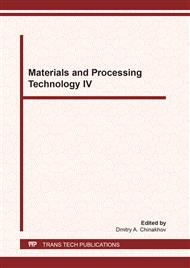p.1
p.8
p.15
p.22
p.31
p.41
p.50
p.59
Crack Resistance Increase of Bushings while Assembling Joints with Tension
Abstract:
In order to restore worn parts during repair work, it is often used to press the repair bushings. While assembling joints, cracks may form in the spanning part (bushing), as it may have surface and structure defects. Therefore, an urgent task is to increase the crack resistance of joints with tension during its assembly. The paper examines the influence of the geometry of the spanning part on the process of cracking. To assess the effect of defects on the crack formation, the method of modeling defects with a surface crack of a semi elliptical shape was used. The crack resistance is estimated using the force criterion of fracture mechanics – the stress intensity coefficient. As a result, it was found that the ratio between the wall thickness of the enclosing sleeve and its outer diameter has a significant effect on the crack resistance of the joint with tension, which allows reducing the origin probability and crack development during its pressing by varying these parameters. While assembling joints, the following methods are often used: mechanical-using a press and thermal with heating of the covering part. When the method of joint with cooling of the covered part, the greatest strength of the joint is achieved, but the probability of cracking increases. This is because when the temperature of the enclosing sleeve decreases in contact with the cooled shaft, the critical stress intensity coefficient (fracture toughness), which is a mechanical characteristic of crack resistance, decreases. To reduce the effect of cooling the sleeve, you can use a combined method of assembling the joint, in which the covered part is cooled and the covering part is heated. It is shown that to assess the fracture resistance at low temperatures, it is optimal to conduct full-scale tests, where the cooling and heating temperatures of the press joint parts are the experimental factors.
Info:
Periodical:
Pages:
22-30
Citation:
Online since:
January 2021
Authors:
Price:
Сopyright:
© 2021 Trans Tech Publications Ltd. All Rights Reserved
Share:
Citation:


